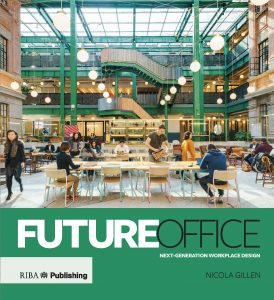Nicola Gillen of AECOM explores how emerging technology and changing needs will shape the next generation of workplace design
Despite frequent predictions of its demise, the office is a space that continues to evolve and endure and remains a central part of our working lives.
But, the office and people’s ways of working are changing significantly. Digital technologies are rapidly reshaping what we do and how our workplaces need to be conceived, built and operated. Driven by automation and artificial intelligence (AI), the Fourth Industrial Revolution means that some jobs will cease to exist in the coming years while others will be created.
With four generations in the workplace for the first time, we also need offices that support and adapt to the needs and talents of all those who work there, fostering constructive interaction and collaboration. As the world around us shifts, so too must the approach of those who design, build and maintain our physical and virtual offices.
For generations, the construction industry has followed a ‘linear economy’ model with materials and resources mined, manufactured, used and then thrown away. With the global demand for resources surging, raw materials becoming harder to extract and the threats of climate change increasing, this status quo cannot hold.
The circular economy model offers an alternative, more sustainable, ‘regenerative’ approach, prioritising the retention and refurbishment of buildings over demolition, and designing for the separation and reuse of materials at the end of a building’s life. By designing buildings with more modular elements that can be deconstructed, adapted and reconstructed, we can extend their life and enable resources to be salvaged and reused.
Similarly, ensuring greater energy efficiency must be a priority for next-generation workplaces, not just to reduce costs but also to meet global emissions targets. As a result, the future of office power will be electric, with more buildings generating their own power via built-in solar panels and using low carbon and energy-efficient solutions, such as heat pumps and heat recovery.
Innovation purely for innovation’s sake quickly dates. What matters most is ensuring that the latest technologies deployed in workplaces support users, enabling them to work more efficiently together. To that end, with more of us equipped to work on the move, there’s a growing need for flexible workplaces designed to bridge the gap between home and more traditional workspaces. This, in turn, is having a profound effect on the wider market for office space, both financially and physically.
Unsurprisingly, the shift to more agile working is influencing the future of office design, where a range of formal and informal areas for meetings and collaborative work are interspersed with quieter areas, delivering a wide variety of task-specific workspaces and, crucially, providing valued staff with choice and autonomy.
Building on this, the increasing prevalence of sensors in workplace fixtures, fittings and equipment is already helping offices to adapt to their users’ needs, for example, through learning and responding to people’s individual preferences for light levels and temperature. And, in the future, new technologies could help to make collaboration and individual work even more efficient. Wearables will enable more personalisation of space, and voice and mood sensors in office buildings could recognise the energy of impromptu conversations between colleagues and ‘bring the meeting space to the people’ through a temporary acoustic bubble.
Organisations increasingly recognise that their people are their most expensive and valuable asset. But understanding and measuring the impact of workplace environmental factors on issues such as employee motivation, satisfaction, productivity and mental health is a complex task. A workplace purposely designed around wellbeing must reach beyond the physical and environmental aspects of wellbeing, such as noise, light and indoor climate, to include social and psychological dimensions.
For example, designs should address the diverse factors that comprise a person’s wellbeing: encouraging them not just to move around the office, including using the stairs; but also providing large and small spaces for socialising, relaxing or quiet chats – to boost creativity and community. In addition, the spaces need to be ergonomic and at a human scale, engender a sense of pride and belonging, and provide a welcoming, comfortable team areas that express team identity.
HMRC’s transformation programme is committed to the biggest modernisation of the UK tax system in a generation and involves making fundamental changes to the way HMRC works – becoming a more highly skilled, flexible and tech-enabled organisation. As part of this, HMRC is delivering phase one of the Government Hub programme – which, led by the Government Property Agency, is consolidating Civil Service offices across the UK into fewer, larger, multi-occupied buildings easily reached by public transport.
HMRC’s Croydon Regional Centre is the first such facility. Equipped to support over 2,700 HMRC staff, it is helping replace HMRC’s ageing network of offices with high-quality modern, accessible and inclusive workspaces designed to boost collaboration, wellbeing and productivity. Moveable furniture and partitions make spaces adaptable for different uses and a robust, resilient IT infrastructure supports agile working. Engaging HMRC employees and giving them a clear understanding of the benefits of the locations programme was critical to success. The Croydon Hub was the result of HMRC’s long-term interest in, and evolution of, new ways of working.

This is a pivotal moment for the office – this most familiar of spaces is undergoing significant and extensive change as we enter the next chapter in its history. Workplace designers, developers, occupiers and users need to understand how these changes will impact future workplaces and their own working lives.
The themes of buildings, technology, people and delivery are explored in our new book Future Office: Next Generation Workplace Design, published by RIBA Publishing. The collaborative work of 12 experts in their fields, the book includes real-life workplace and office design projects from across the world to identify lessons for the future.

Nicola Gillen
Workplace Market Sector Lead – Europe, Middle East & Africa
Tel: +44 (0)20 7061 7000
Twitter: @AECOM
LinkedIn: Aecom
YouTube: AECOM Technology Corp
Instagram: Aecom
Facebook: Aecom Technology Corporation












![[VIDEO] UK-based firm reveals ‘world’s first’ fully AI-driven architectural project Studio Tim Fu has revealed the 'world's first' fully AI-driven architectural project in Slovenia, developing six luxury villas on the Lake Bled Estate](https://www.pbctoday.co.uk/news/wp-content/uploads/2025/03/Interior-1-studio-tim-fu-218x150.gif)

